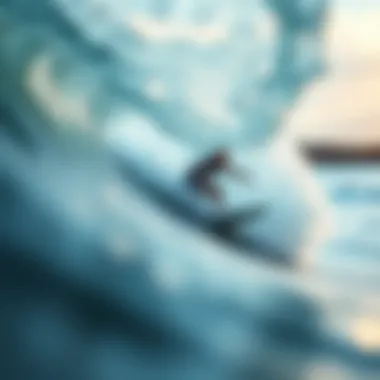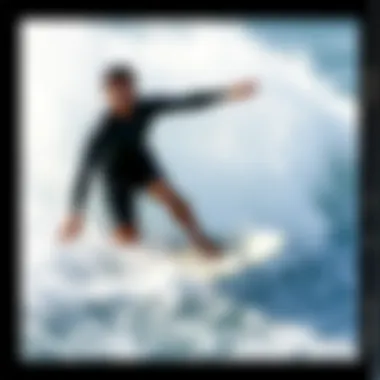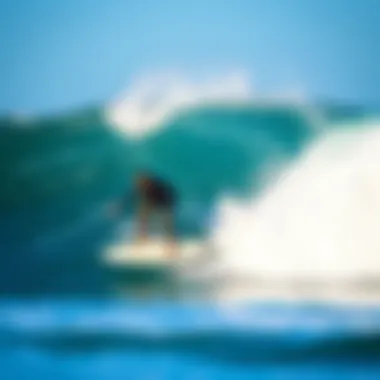Navigating the Waves: A Comprehensive Guide to Surfboarding


Intro
Surfboarding is much more than just hitting the waves. It's a convergence of adventure, skill, and a spirited community. This dynamic sport has attracted individuals from all walks of life, each riding not just the ocean's swells, but also the currents of culture that surround it.
From early days of wooden planks used by Hawaiian islanders to modern high-tech boards made from a collage of materials, the journey of surfboard technology is as fascinating as riding the waves. For both newcomers and seasoned surf enthusiasts, grasping the essentials of gear and equipment is crucial.
In this article, we will immerse ourselves in the world of surfboarding. We'll explore gear and equipment, technical skills, and the culture that influences surfers globally. Whether you’re just getting your feet wet or are an experienced rider seeking something new, this comprehensive guide will help you navigate the complexities of surfboarding like a pro.
The Essence of Surfboarding
Surfboarding isn't merely a sport; it encapsulates a lifestyle, a culture, and a connection with nature that resonates deeply with enthusiasts from all walks of life. Viewed through the lens of adventure, balancing atop a moving wave transcends the physical act, touching on aspects of freedom and self-discovery. Engaging in surfboarding offers individuals a chance to embrace challenges, master skills, and foster a community that thrives on shared experiences and a mutual love for the ocean. The essence of surfboarding lies not solely in riding waves but in understanding the broader implications it has on a surfer's identity and the environment.
Historical Context
The roots of surfboarding can be traced back to ancient Polynesian cultures, where it was not just a recreational activity, but a significant part of social and spiritual life. In those early days, chiefs and warriors would display their strength and prowess on water, turning the ocean into a stage for both competition and community bonding. The practice slowly made its way to the mainland, developing throughout the 20th century into the structured sport we recognize today.
By the mid-20th century, surfing began to capture the imagination of a broader audience. The establishment of the World Surfing Championship in 1966 marked a significant milestone, solidifying its place within the sporting world. Surf culture exploded in the 1970s and '80s, driven by surf films, magazines, and innovative surfboard designs. The sport saw a drastic change in style and approach, turning surfboarding into a global phenomenon that has since inspired countless enthusiasts.
Cultural Significance
Surfboarding holds a unique place in global culture, intertwining itself with music, fashion, and even spirituality. It expresses a deep-rooted connection to the ocean, which many surfers embrace as not just a medium but as a living entity deserving respect and preservation. The act of surfing becomes a form of meditation, offering moments of tranquility amid the chaos of life.
From the iconic beach towns of California to the vibrant surfing spots in Australia, each locale has cultivated its distinctive surf culture replete with local traditions, styles, and even terminologies.
As surf culture roots itself deeper, it has also evolved into a prominent voice for environmental advocacy. Surfers often emerge as stewards for their local waters, raising awareness on ocean conservation and sustainable practices. The mantra of "leave only footprints" resonates loudly in this community, and many surfers honor their commitment to keeping beaches pristine.
Understanding Surfboard Technology
In the realm of surfboarding, technology plays a pivotal role. Understanding surfboard technology encompasses a range of elements, from the type of materials used to the design innovations that are constantly being introduced. Each aspect of surfboard technology influences performance, durability, and the overall surfing experience. As surfers dive into the waves, knowing the ins and outs of surfboard technology can set them apart in their journey, be it as a beginner or an experienced professional.
Types of Surfboards
Surfboards come in various shapes and sizes, each tailored to different surfing styles and conditions. Here, we explore the four primary types that every surfer should familiarize themselves with.
Shortboards
Shortboards are the go-to choice for many advanced surfers. They are typically about 5 to 7 feet long and designed for high-performance maneuvers. What makes shortboards versatile is their narrow outline, which allows for sharper turns and quick maneuvers.
The key characteristic of shortboards is their minimal volume and thin design, which facilitates speed and agility on the wave. This makes them a beneficial choice for experienced surfers looking to ride fast, powerful waves. However, shortboards may be a bit trickier for beginners due to their reduced stability and smaller surface area.
"Shortboards are like sports cars on the water—fast, flashy, and built for performance."
Longboards
Longboards, on the other hand, are favored for their stability and ease of use, making them an excellent choice for beginners. They generally range from 8 to 12 feet and have a wider nose and tail, which promotes a gentler ride. The unique feature of longboards is their buoyancy, which allows surfers to catch smaller waves and ride them smoothly.
The added length means that longboarders can showcase a variety of styles, including graceful nose rides and smooth turns. While longboards might not offer the same level of agility as shortboards, their forgiving nature makes them ideal for those just starting on their surfing journey.
Fish Boards
Fish boards are characterized by their distinct swallowtail and wider stance, which cultivate speed and control on smaller, less powerful waves. Typically shorter than longboards but wider than shortboards, fish boards are excellent for surfers looking to maximize performance with reduced effort.
The key aspect of fish boards is their buoyancy; surfers can paddle less vigorously, making this type a popular choice for those searching for a unique surfing experience. They excel in choppy conditions due to their ability to maneuver quickly, although they may not handle larger waves as effectively as their longboard or shortboard counterparts.
Funboards
Funboards can be seen as a middle ground between longboards and shortboards. They usually range from 7 to 8.5 feet and combine characteristics of both types, providing a versatile experience for surfers of all skill levels. The unique feature of funboards is their surfability in a variety of conditions while still offering enough maneuverability for some tricks.
These boards are ideal for those who want a bit more flexibility and excitement without sacrificing stability. Funboards are particularly beneficial for intermediate surfers eager to progress their skills without diving into the high-performance territory of shortboards.
Materials and Construction
Delving deeper into surfboard technology, the materials and construction significantly impact not only performance but also the weight and durability of the board.
Polyurethane
Polyurethane foam is the traditional material used in surfboard construction. With a light, buoyant quality, polyurethane boards offer great performance. This material is easily shaped, allowing for customized designs tailored to individual surfers' needs.
However, they can absorb water over time, which may lead to weight gain and reduced performance. As such, surfers must be mindful of maintenance to keep their boards in optimal condition.
Epoxy
Epoxy surfboards are becoming increasingly popular due to their durability and lighter weight compared to polyurethane boards. Made with epoxy resin and a polystyrene core, they withstand dings and breaks better than traditional boards.
The key characteristic of epoxy is its strength-to-weight ratio, making it a popular choice among performance surfers. On the downside, the rigidity of epoxy can sometimes make these boards feel less responsive in certain conditions.
Carbon Fiber
Carbon fiber is primarily used in high-performance boards where every ounce matters. Its lightweight nature and exceptional strength make it an efficient choice for surfers looking to enhance speed and agility. This material promotes a stiff flex pattern, which benefits those performing advanced tricks and maneuvers.
However, carbon fiber boards can be pricey, and their stiffness might not suit every surfer's style, particularly beginners who may require a bit more forgiveness in their board during learning.


Advancements in Design
The design of surfboards is in constant evolution, driven by technological advancements that push the boundaries of what surfers can do on the water.
Aerodynamics
Aerodynamic design focuses on reducing drag as the surfer moves through the water. Boards with improved aerodynamics can achieve higher speeds and greater stability, enhancing the overall surfing experience. This design often features tapered tails and contoured bottoms that help the board glide effortlessly across the surface of the water.
Surfers benefit immensely from these design advancements, especially when riding powerful waves where speed is essential.
Fin Systems
The fin system plays a crucial role in a board's performance and maneuverability. Different setups, including thrusters, quads, or single fin, can completely change how the board handles in waves. The primary characteristic of fin systems is that they allow surfers to customize their experience based on the conditions they will face.
Choosing the right fin setup can significantly enhance responsiveness and control, making this feature essential for anyone looking to improve their surfing skills.
Volume and Shape
Finally, the volume and shape of a surfboard decide how it performs under various conditions. Boards with greater volume tend to float better, aiding beginners in paddle and wave-catching. Conversely, shape can influence how a board responds to different types of waves and maneuvers.
Understanding these elements enables surfers to choose boards that align with their personal style and the kind of waves they wish to tackle, ensuring a more fulfilling ride on each outing.
By comprehending the breadth of surfboard technology, from types to materials and advanced design characteristics, surfers can make informed decisions that enhance their experience on the water.
For more information on surfboard technology, consult resources like Wikipedia, or check out forums on Reddit.
Engage with first-hand experiences and discussions on social media platforms such as Facebook to learn what works best for surfers in various conditions.
This knowledge lays the foundation for a successful surfing experience while navigating the waves.
Techniques for Beginner Surfers
When it comes to surfing, mastering the foundational techniques is crucial for newbies. It’s like learning to walk before you can run; without a good grasp of the basics, a surfer's journey can quickly turn into a struggle rather than a thrill. The right techniques not only boost confidence but also enhance safety out on the waves. Each element—be it balance, paddling, or wave catching—plays a major role in shaping a surfer's overall experience.
Basic Stance and Balance
For any surfer, getting the stance right is essential. A solid stance not only increases balance but also sets the stage for a successful ride. Typically, beginners should focus on positioning their feet shoulder-width apart, with knees slightly bent. This stance allows for better weight distribution and stability on the board. It's important to keep the body relaxed yet alert. One tip is to envision oneself as a tree; strong but flexible.
"You don't learn to surf straight away. It's a gradual process, much like planting a tree; you need to nurture the roots before it can stand tall."
Practicing on land can be beneficial before hitting the water. Stand on your surfboard on dry ground, practicing shifting your weight from one foot to the other. When the time comes for riding waves, this will feel more natural. Moreover, surfers should pay attention to their head position; keeping it up and looking ahead helps maintain balance and prevents falls.
Paddling Techniques
Paddling is perhaps one of the most underrated aspects of surfing. Many beginners focus so much on standing that they overlook how to effectively paddle. Good paddling form can determine whether a surfer reaches the wave in time to catch it.
To paddle efficiently, beginners should lie on their stomachs with their chest on the board. Keeping the body aligned in the center allows for better buoyancy and less drag. The arms should enter the water finger-first and pull back in a sweeping motion, like a slow but steady scull. It’s about rhythm; a staggered approach, alternating arms can create a more fluid motion.
Here’s a simple breakdown of paddling:
- Keep it relaxed: Tension in the body wastes energy.
- Engage your core: Use your torso muscles to generate power.
- Mind the waves: Be aware of incoming waves to paddle at the right moment.
Catching Waves
Catching a wave is the crowning achievement for any beginner, and understanding the dynamics involved is vital. Timing is key. A surfer should start paddling when they see the wave begin to rise. As the wave approaches, it is important to paddle with vigor and determination.
Once the wave starts rolling under the board, thrusting the body up into a standing position in one swift movement is crucial. This might feel overwhelming at first, as it requires coordination and balance. But every fall teaches a lesson, so persistence is key.
Some techniques to keep in mind when catching waves:
- Angle your board: Positioning the board at a slight angle can help in catching the wave more efficiently.
- Leverage your weight: Leaning forward when on a fast-breaking wave keeps the board steady.
- Practice falls: Learning how to fall correctly can save beginners from injuries. When falling, try to do so away from the board and dive down to avoid getting hit.
A solid understanding of these basic techniques can significantly improve a beginner's surfing journey. From stance to paddling and ultimately catching their first wave, each element builds the foundation for progressing in this exciting sport.
Intermediate and Advanced Techniques
When surfers reach a certain level of competence, they begin seeking not just to maintain balance or catch waves, but to enhance their experience and expression on the water. This section delves into the intermediate and advanced techniques that empower surfers to refine their skills and elevate their performance. Mastery of these techniques is pivotal in understanding one's surfing style, improving agility, and boosting overall confidence in tackling new challenges.
Turning and Carving
Turning and carving signify the transition from basic riding to more dynamic maneuvers. Turning involves changing direction while maintaining momentum, a skill that allows surfers to navigate their path on a wave effectively. Carving, on the other hand, is about making sharp, defined movements that leave a mark on the wave’s surface, showcasing control and style. Both these skills play a crucial role in wave selection and positioning: the better a surfer can turn and carve, the more likely they are to catch and ride waves efficiently.
A proficient turn can also be the entry point for more advanced tricks. For instance, timing a turn just right can set a surfer up for a maneuver like a cutback or even an aerial. Carving on the face of the wave, continuous shifts in weight create a dance with the ocean, boosting a surfer's ability to harness energy effectively.
Tricks and Maneuvers
As surfers grow more comfortable on their boards, they often want to push their limits with tricks and maneuvers. Not only are these skills entertaining to perform, they also enhance the aesthetic and technical aspect of surfing.
Cutbacks
The cutback is a classic maneuver that showcases fluidity and control. It involves digging the rail into the wave as the rider turns back towards the breaking part of the wave, allowing them to maintain their momentum. The key characteristic of a cutback is its smoothness; executed well, it appears almost effortless. This technique is often favored for its visual appeal, demonstrating a rider's ability to stay connected with the wave.


A well-executed cutback can throw water into the air, creating a stunning visual effect, which can lead to higher scores in competitions.
The advantage of the cutback lies in its versatility; it can be performed on various wave types, making it a staple in a surfer's repertoire. However, mastering this maneuver does require practice and a keen understanding of wave dynamics, as improper execution can lead to losing speed or even falling off the board.
Aerials
Aerial maneuvers represent the upper echelon of surfing tricks, involving taking off the lip of the wave and performing tricks in the air before landing back on the board. The new key characteristic here is height and rotation; the more stylish volleys and spins you can perform, the more points you’ll typically score in competitions. Aerials are celebrated for their breathtaking nature and the technical prowess they require.
The unique feature of an aerial is how it showcases a surfer's creativity and skill. Surfers can opt for a simple grab or try complex rotations, varying the difficulty of their performances. The primary disadvantage is the risk involved; one miscalculation can lead to a wipeout. Thus, it’s crucial to practice aerials on smaller waves before attempting on larger sets.
Off the Lip
The off the lip maneuver brings a distinct flair to a surfer’s performance by enabling them to launch off the top edge of a wave. This technique is characterized by the thrill of hitting the lip with speed and precision; doing so showcases agility and strength.
What makes the off the lip a beneficial choice for surfers is its ability to generate style and excitement. It not only enhances the ride but also gets others’ attention, often transforming a basic wave ride into something spectacular. A challenge lies in achieving the right timing and angle when approaching the lip, as poor execution can result in a frustrating fall.
While the thrill of learning these intermediate and advanced techniques can be intoxicating, they also require patience and diligent practice. Surfers should be prepared to invest time in developing their skills and understanding the nuances of each maneuver. Building a solid foundation in the basics will pay off tremendously when tackling these advanced techniques.
Essential Gear for Surfers
In the world of surfboarding, one cannot overlook the importance of gear. Choosing the right gear not only enhances performance but also ensures safety and comfort while navigating the unpredictable waves. For both seasoned surfers and novices, understanding these essentials can make the difference between a delightful day on the water and a series of frustrating sessions.
Choosing the Right Wetsuit
A wetsuit acts as a second skin, offering insulation and protection against chilly waters. When selecting a wetsuit, the thickness of the neoprene material is a key consideration. Typically, it ranges from 2mm to 6mm, depending on water temperature and personal preference. A snug fit is also critical; if the wetsuit is too loose, it may let in water and reduce warmth.
"Not every wetsuit is created equal—the right fit ensures that you stay toasty while catching those killer waves!"
Furthermore, wetsuits come in various styles, including shorties, long sleeves, and full suits. Choosing the right type should align with the surf conditions and the time spent in the water. A common mistake is to choose style over content; comfort is paramount whether you're riding at dawn or dusk.
Surfboard Accessories
Accessories can significantly enhance one’s surfing experience, impacting both safety and performance.
Leashes
A surfboard leash is often overlooked, but its significance cannot be underestimated. This accessory connects the surfer to their board, ensuring that it doesn’t drift away after a wipeout. The standard length corresponds to the size of the board, typically around 6 to 10 feet.
Leashes are most popular for their reliability. A good leash prevents the board from becoming a hazard to others in the water, keeping the surfer in control of their equipment. Given its straightforward function, it’s surprisingly vital—it also helps you quickly get back to paddling and riding the next wave! Quality leashes often feature durable materials that resist wear and tear, adding to their long-lasting appeal.
Wax
Surfboard wax plays a critical role in ensuring traction. Without proper wax, a surfer risks slipping off the board—an unpleasant experience, to say the least. Wax is usually available in different temperatures, catering to varying water conditions. The choice of wax depends on factors like water warmth; warmer waters require softer wax, while colder waters necessitate harder options.
Its unique texture is designed to provide grip, crucial for performing tricks. A well-waxed board also allows for better maneuverability during rides, facilitating those sharp turns and radical tricks. However, there’s a downside: excess wax can accumulate, making for a sticky situation that needs regular maintenance.
Fins
Fins are an integral part of a surfboard’s performance. They influence stability, speed, and control while navigating through waves. Different fin configurations impact how a board behaves in water; for instance, a thruster setup (three fins) is known for providing balance and maneuverability, making it a favored option among many surfers.
The key characteristic of fins is their ability to provide better grip when carving and turning, which is essential for skillful surfing. They come in a variety of materials, such as fiberglass, which offers both responsiveness and flexibility. A downside is that the wrong fin type for your board can lead to inefficient performance, essentially forcing a surfer to rethink their approach.
Safety Equipment
Lastly, safety gear is crucial, especially for those venturing into larger swells or unknown waters. While surfing can be exhilarating, it's essential to ensure that you are prepared for unforeseen circumstances.
Helmets
Although surfing helmets are not as common, wearing one can provide peace of mind. A helmet protects against impact from falling boards or collisions, especially in crowded surf spots. Many models are lightweight and floating, ensuring they don’t hinder performance while also offering ample coverage.
The unique feature of helmets is that they come with various padding options, which can be adjusted based on personal comfort. Some helmets also incorporate ventilation systems, adding comfort during lengthy sessions. However, a drawback may be a slight decrease in mobility, as some surfers find them cumbersome.
Impact Vests
Impact vests serve as an additional layer of protection. These buoyant vests can absorb shocks during hard falls, reducing the risk of injury. They are particularly popular among surfers executing aerial maneuvers, where the chance of a hard landing is greater. The buoyancy of the vest not only enhances safety but can also improve confidence, encouraging surfers to push their limits.
A key characteristic of impact vests is their fitted design, allowing for freedom of movement while offering ample protection. However, it’s worth considering that not all vests are crafted from the same material, so spotting quality construction is essential before making a purchase.
Surfboarding Locations
The world of surfboarding is as vast as the oceans themselves. It's not just about riding the waves; it's about the places where those waves break. Surfboarding locations play a pivotal role in shaping the experience of surfers, offering a variety of conditions that cater to different skill levels and styles. From renowned spots that attract surfers by the thousands to hidden gems waiting to be discovered, each location brings its own flavor to the sport. Choosing the right spot can enhance both skill development and overall enjoyment, making it an essential topic for any surfer eager to navigate the waves.
Popular Surf Spots Worldwide
When it comes to surfboarding, three locations stand out globally: Australia, California, and Portugal. Each has its own characteristics that not only attract thrill-seekers but also provide a sense of community among surf lovers.
Australia
Australia, known for its stunning beaches, is a paradise for surfers. The Great Barrier Reef and the Gold Coast are perhaps two of the most famous areas to catch some waves. The unique aspect that makes Australia particularly special is the variety of surf conditions available—from gentle, rolling waves suitable for beginners to challenging swells that will put even the seasoned surfers to the test.
What makes Australia's surf culture thrive is its community spirit. Beach life is not just a pastime but a way of connecting with nature. The weather is also an attractive feature, providing near-year-round surf opportunities. The downside? The coastal regions—particularly during peak seasons—can be overcrowded, leading to some frustrating experiences in the water. Still, the spirit of surf camaraderie often shines through, making any experience worthwhile.


California
California's surf scene is iconic. The beaches from Santa Cruz to Huntington Beach are famous not only for their scenery but also for their surfing history. The consistent waves found here make it a go-to spot for both beginners and experienced surfers. One key characteristic is the vibrant surf culture that flourishes in the state. You’ll find surf shops, schools, and competitions galore.
A unique feature is the variety of surf competitions held annually, attracting top talent from around the world. This provides an opportunity for surfers to witness high-level performances while fostering an atmosphere of learning and growth. However, like Australia, certain beaches can become packed during the summer months, which can dampen the experience for those looking to catch a wave in solitude.
Portugal
Portugal has emerged as a hot spot for surfing in recent years. Its long coastlines and Atlantic swells make it an attractive destination, especially in places like Ericeira and Nazaré, known for impressive waves. The distinct feature of Portugal lies in its diverse surfing terrain, which caters to all levels—from learner-friendly beaches to advanced breaks suitable for big wave surfing.
In addition to excellent surf conditions, Portugal offers a rich cultural experience. Culinary delights and historical sites allow surfers to soak in more than just wave riding. On the downside, while the summer can be quite crowded, many less well-known spots remain relatively unvisited, providing a quieter experience for those willing to explore.
Offbeat and Hidden Gems
While the popular surf spots are well-known and often crowded, there are plenty of offbeat locations that offer a more serene surfing experience. Finding these hidden gems can lead to thrilling sessions away from the main crowds. When searching for offbeat locations, consider:
- Local Recommendations: Asking locals or surfing forums can unveil lesser-known spots.
- Seasonal Changes: Some beaches may have great conditions during specific times of the year when other spots are flat.
- Weather Dynamics: Understanding local weather patterns can give insights into less-frequented areas that hold surfable waves.
Ultimately, exploring these offbeat locations not only enhances the thrill of the sport but also encourages surfers to develop an appreciation for the natural beauty that surrounds them. Embracing the adventure off the beaten path allows for more intimate and memorable experiences on the water.
The Surf Culture
The surf culture extends far beyond simply riding waves. It's a lifestyle, a community, and a unique form of self-expression deeply woven into the fabric of coastal life. For countless enthusiasts, surfboarding is not just a sport; it embodies a way of living, understanding, and relating to the world around them.
Surf Lifestyle
Embracing a surf lifestyle often means adopting a laid-back attitude, where the thrill of riding a wave frequently takes precedence over mundane daily concerns. This culture promotes a connection with nature, as surfers develop a sense of respect and appreciation for the ocean. Surfers often find themselves drawn to coastal areas, forming bonds with fellow surfers while sharing stories of triumph and falls.
Moreover, surfing creates a platform for personal growth and introspection. Each ride has its challenges and teaches you about balance and patience.
- Surfing above all: Many surfers prioritize their sessions, willing to wake up at the crack of dawn to catch the perfect wave.
- Traveling for waves: The quest for the ultimate surf spot can lead to unexpected adventures and global friendships, enriching one's personal journey.
- Community bonds: Surfboards are often a bridge connecting people from diverse backgrounds.
Music and Art
The vibrant surf culture has significantly influenced music and art, creating a distinct style that resonates with the ethos of the sport. The sounds of rhythmic guitar strumming are synonymous with classic surf films and beach hangouts. Bands like The Beach Boys popularized surf music, encapsulating the carefree essence of the wave-rider lifestyle.
In art, the surf scene has inspired various creative avenues.
- Element of aesthetics: The colorful surfboard designs often reflect a surfer's personality, bridging the gap between function and art.
- Photography and films: Visual storytelling showcases the adrenaline rush and beauty of surfboarding, inspiring many to paddle out themselves.
Artists like John Van Hamersveld and Thomas Campbell have captured the essence of surf culture through their work, celebrating wave-riding as an art form in its own right.
Environmental Awareness
The ocean is both a playground and sanctuary for surfers, making environmental awareness paramount within the surf culture. Knowledge of marine ecosystems and active participation in preservation efforts illustrates surfers' dedication to the planet.
Surfers have initiated numerous movements aimed at keeping oceans free from waste and pollution. Their voices amplify concerns regarding climate change, ensuring that the natural wonders they cherish are safeguarded for future generations.
Several key points underscore this commitment:
- Local cleanups: Many surf communities regularly organize beach clean-ups, fostering a sense of shared responsibility.
- Eco-friendly gear: Increasingly, surfers are choosing eco-friendly boards and accessories to minimize their impact on the environment.
- Advocacy for policy change: Surfers often partner with environmental organizations to promote legislation that protects marine environments, proving the sport can foster social activism.
"We don't just ride the waves; we're part of the ocean's story. It's our job to keep it healthy for the next generations."
The surf culture is an intricate tapestry, woven with the threads of lifestyle, art, and environmental stewardship. It thrives on community, creativity, and camaraderie, making it a cornerstone of the surfing experience.
Future of Surfboarding
As surfing continues to evolve, the future of surfboarding paints an exciting picture. This topic holds significant importance as it encapsulates the merging of technology and environmental shifts affecting surfers worldwide. By looking closely at technological innovations, climate influences, and competition landscapes, we can anticipate how surfboarding will develop in the coming years.
Technological Innovations
Technology in surfboarding is moving at a breakneck pace. Surfboard design is becoming increasingly sophisticated. Modern surfers can already enjoy products that feature smart technologies, such as IoT-enabled boards that track performance metrics. Companies exploring this space are not shy about investing in research and development to improve the overall surfing experience.
- Adaptive Surfboards: These boards can adjust buoyancy and responsiveness based on surf conditions. Imagine zipping through a wave and having real-time feedback on your performance.
- Wearable Tech: Devices like smartwatches have become popular among surfers, providing crucial insights into paddling distance, wave count, and even heart rate during rides. This data-rich approach allows surfers to refine their techniques.
- Eco-Friendly Materials: Sustainability is becoming a primary focus in surfboard manufacturing. New materials, like bio-resins and recycled products, are being tested and developed to reduce environmental impact.
As these innovations push the boundaries of what's possible on the waves, surfers must stay updated to maintain a competitive edge.
Changing Waves and Climate Impact
Climate change presents a series of challenges and shifts that the surfing community must embrace. As sea levels rise and ocean temperatures fluctuate, traditional surf spots might transform. This warrants careful consideration by surfers and environmentalists alike.
- Wave Alteration: With changing climate, many beloved surf breaks might alter in size or frequency, presenting both an opportunity and a challenge. Surfers may need to adapt their skills to tackle new conditions.
- Pollution Concerns: More frequent storms can lead to increased waste in the water, jeopardizing the quality of popular surfing locations. It's essential for surfers to engage in eco-friendly practices to preserve their sport.
- Rising Tides: Coastal erosion and shifting tides play a significant role in determining where and when to surf. Understanding these factors is crucial for both safety and enjoyment.
Surfers are often on the frontlines of climate conversations. Their efforts to preserve the ocean haunt society to pay more stringent attention to global changes.
Global Surfing Competitions
Competitive surfing continues to grow in popularity, evolving into a global spectacle. Events like the World Surf League (WSL) showcase the pinnacle of talent, but there’s more beneath the surface. Not only do these competitions elevate the sport's profile, but they also foster community.
- Increased Participation: With rising interest in surfing, more competitions are organized, ranging from grassroots to professional levels. This inclusivity encourages individuals of various backgrounds to join.
- Viewership and Media: The evolution of digital media amplifies surf competitions. Streaming platforms and social media enable spectators worldwide to follow their favorite surfers live.
- Diversity in Surfing: The emergence of events focusing on women’s and amateur competitions signifies shifting norms in what it means to be a surfer. More people are seeing themselves represented on the waves.
Surfing competitions not only promote healthy competition but also galvanize the community around environmental causes, making them an integral part of the future of surfboarding.
"As we look forward, embracing technological innovations and understanding environmental changes will define the next wave of surfboarding culture."
By keeping a finger on the pulse of these developments, surfers can remain deeply connected to the essence of their sport while preparing for its future challenges and possibilities.
For more insights on these trends, surf enthusiasts can explore resources like Wikipedia, or community discussions on platforms like Reddit.







